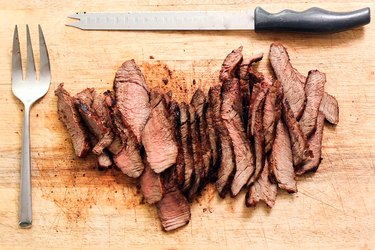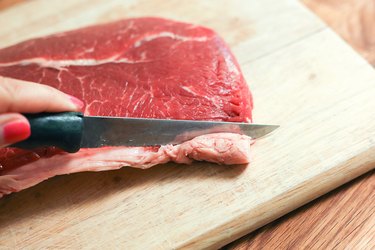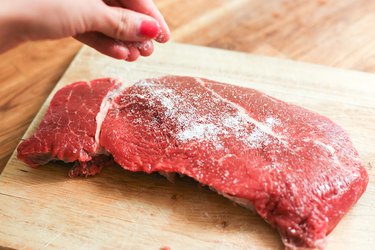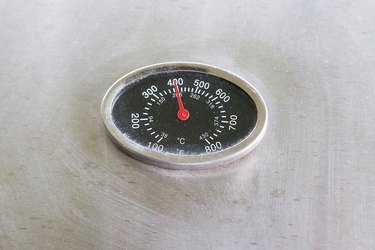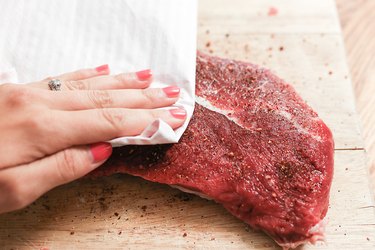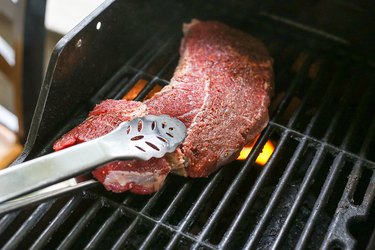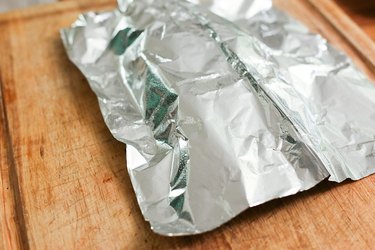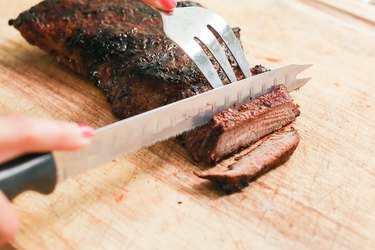For steak lovers, cuts from the shoulder or "chuck" represent a maddening quandary. On the plus side, they're inexpensive and pack a potent beefy flavor. Unfortunately, they're also tough and usually well-furnished with gristle and thick seams of fat. Most cooks and cookbooks dismiss the notion of grilling chuck steaks because of their toughness, but when it's handled well, a grilled chuck steak can still be enjoyable.
Set Your Expectations
Video of the Day
There's no culinary magic you can work to make a chuck steak as tender as a rib eye or a T-bone, so adjust your expectations accordingly and enjoy your steak for what it is. By all means, tenderize it before it's cooked, but the most important step is slicing the chuck thinly across the grain after it's come off the grill. That shortens the tough muscle fibers and leaves your slices of steak with the same kind of pleasant chewiness you'd find in a lobster tail or calamari ring.
Video of the Day
Step 1
Trim any excess fat from around the edges of your steak and, if you wish, cut out any thick seams of fat or gristle. Sometimes you'll need to tie the steak with butcher's twine when you're done to hold it together. Alternatively, you can pin any loose pieces in place with bamboo skewers or wooden toothpicks, but you'll need to remove those before slicing and serving the steak.
Step 2
Season the chuck steak liberally with coarse salt, then leave it to rest for at least 45 minutes. The beef's own juices will dissolve the salt, then absorb the resulting brine. Not only does that flavor the steak more effectively than salting at the table, it improves the steak's texture and has a mild tenderizing effect.
Step 3
Preheat your gas grill to 400 degrees Fahrenheit, or light the coals on your charcoal grill and let them burn down until they're covered with a thin layer of ash.
Step 4
Dry any surface moisture from the steak with paper towels. Turning that moisture to steam requires a lot of energy, and your steak won't brown properly until it's gone. Brush or spray the steak lightly with oil to enhance browning and prevent sticking, then set it on the preheated grill.
Step 5
Grill your steak for 14 to 20 minutes, depending on its thickness, or until it reaches the correct internal temperature when tested with an instant-read thermometer. As with other tough cuts, shoulder steaks are tenderest when cooked to medium-rare or medium, so watch for its temperature to reach 125 to 135 F.
Step 6
Rest your steak for 5 minutes or longer on a cutting board or preheated plate, covered loosely with a sheet of aluminum foil. The resting time gives your steak a better texture when cut, and gives you a few minutes to bring your side dishes to the table.
Step 7
Slice the steaks thinly across the grain at a diagonal and serve them with your favorite side dishes.
Tips
• Pounding the steak with a meat mallet, marinating it briefly or sprinkling it lightly with a commercial tenderizer can all make it easier to chew, though each is less important than slicing your steak thinly once it's done.
• Shoulder steaks have a richly beefy flavor of their own, so marinades, spice rubs and sauces are entirely optional.
• Some muscles within the shoulder are surprisingly tender, and many butchers will cut these specialized steaks for you on request. The "top blade" or "ranch" steak is a surprisingly tender piece of shoulder, aside from a vein of gristle that runs down its middle. The chef-friendly flatiron steak is a smaller gristle-free portion cut from the top blade. The "petite tender" is a thin, flat piece of the loin muscle extending into the shoulder, which makes it one of the choicest cuts from the chuck. It's usually grilled whole and then sliced into medallions, like a pork tenderloin.
